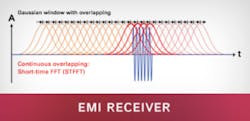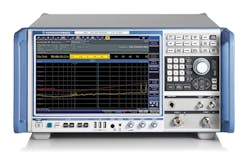Digital EMI receivers and real-time spectrum analyzers have become possible because of advanced ADC technology as well as the availability of high-speed DSP devices. Both instrument types sample unknown signals in the time domain and derive frequency-domain information via versions of the Fourier transform—often the fast Fourier transform (FFT) and short-time FFT (STFFT).
A wide instantaneous bandwidth is a distinguishing feature, which leads to a large number of benefits beyond those available in classical analog equipment. Nevertheless, the two product types differ in their use of the Fourier information. In a real-time spectrum analyzer, the objective is to measure all of the frequencies present within a given band in such a short period of time that transient events will be captured. If each spectrum can be computed quickly enough, a persisted display of successive spectra will preserve the dynamic nature of the signal frequencies. Implementing a means of comparing successive spectra leads to features such as color grading, which highlights frequently occurring features.
Even with high-speed ICs, current technology limits the FFT repetition rate to a few megahertz. This means that a fast transient will be significantly affected by the windowing function applied to reduce spectral leakage. The solution is to use overlapping STFFT spectra that have been offset by a sufficiently small spectral distance to ensure high-fidelity transient capture, as shown in Figure 1.
Courtesy of Rohde & Schwarz
Starting with frequency-domain data similar to that used in a real-time spectrum analyzer, an EMI receiver implements algorithms that allow compliance with the same CISPR specifications as have governed analog instruments but with much higher measurement speed. A Rohde & Schwarz white paper1 helps to explain the benefits of a modern EMI receiver.
The paper states, “The IF contains the spectrum to be measured in the time domain—hence the term ‘time domain scan.’ The FFT parameters and the time-domain signal window are set in such a way that the resolution bandwidth and filter characteristics match the IF bandwidths stipulated in CISPR 16-1-1. In this way, the receiver implements a filter bank with, say, several thousand parallel filters. After each of these filters there are a rectifier and detectors. Instead of a single measured value representing the frequency range of each measurement bandwidth (e.g. 9 kHz), this approach delivers a large number of parallel measured values covering the frequency range of several thousand measurement bandwidths at the same time. This reduces the measurement time by a factor that corresponds to the number of parallel measurement bandwidths.”
EMI measurements are characterized by a specified bandwidth, such as 9 kHz. With a classical receiver, a frequency scan is performed in which the IF bandwidth is successively stepped through the overall band to be scanned. This takes time because the various detectors must settle after each step. The receiver also must dwell at the new center frequency for a specified period.
In contrast, a wide instantaneous bandwidth simultaneously captures spectral data across the entire band. Reference 1 also clarifies how CISPR requirements are met. The paper continues, “A frequency bin represents the measurement bandwidth of the FFT frequency. The frequency bin is observed versus time, across a large number of FFTs…. The level versus time corresponds to the video voltage present in the classic test receiver after the IF filter and rectifier. The big advantage of the FFT-based method is that it delivers a very large number of video voltages at the same time by lining up the FFT-computed spectra. The measurement bandwidth of each frequency bin in the FFT corresponds to the IF bandwidth in the classical receiver.
“The FFT works like multiple IF filters arranged next to one another in the frequency range. The classic receiver feeds the video voltage to the detector circuit directly. Similarly, the FFT-based receiver feeds multiple video voltages at once to a large number of digital detector circuits.”1
Practical implementations
Mark Terrien, EMC marketing engineer at Keysight Technologies, provided additional insight. He said, “FFT technology has not superseded superheterodyne technology, but rather complements it. Modern EMI receivers covering a broad frequency range, as needed for commercial and military compliance measurements, use a combination of superheterodyne and FFT technologies: superheterodyne frequency translation from the emission frequency to an intermediate frequency (IF), where the signals are then digitized and processed in the IF bandwidth using FFT technology.”
He cited three new types of measurement capabilities made possible by FFT analysis at IF: time-domain scanning EMI receivers, receivers with simultaneous active sweep and measurement detectors, and real-time spectrum analyzers. Operation of an FFT-based EMI receiver can be very fast because the instrument only needs to dwell once for the required time while a wide range of frequencies are measured. Without time-domain scanning, the instrument would need to dwell at each frequency as the scan was incremented one step at a time.
According to Terrien, the company’s N9038A MXE EMI receiver covers traditional microwave frequencies for CISPR and MIL-STD-461 testing as well as FCC and EN millimeter-wave frequencies for intentional-radiator emission measurement. He said that this flexibility and operation up to 44 GHz were important capabilities when working with 802.11ad and 5G millimeter-wave devices.
The N9038A is available with several upper frequency limits: 3.6 GHz, 8.4 GHz, 26.5 GHz, and 44 GHz. All models have a 3-Hz DC-coupled lower limit, increasing to 10 MHz when AC coupled. CISPR bandwidths of 200 Hz, 9 kHz, 120 kHz, and 1 MHz as well as MIL-STD-461 bandwidths of 10 Hz, 100 Hz, 1 kHz, 10 kHz, 100 kHz, and 1 MHz are provided. The standard instantaneous bandwidth is 10 MHz, increasing to 25 MHz with Option B25 and to 85 MHz with Option B85. SFDR with Option B85 is specified as -76 dBc, nominal.
Among supporting tools that Keysight offers is a full measurement suite, which helps the user walk through the entire range of compliance measurement activities from instrument setup through data collection and analysis and report generation. Terrien said, “We also offer a capability we call strip chart, which allows customers to collect and monitor an emission as a function of time.” The feature can verify that the maximum value of an emission was attained during antenna height scanning or turntable rotation.”
Multiresolution
Gauss Instruments has developed the TDEMI series of measurement equipment. As described in the product brochure, “Ultra high-speed analog-to-digital converters in combination with digital real-time signal processing provides the advantage of well-known measuring instruments like oscilloscopes, EMI receivers, as well as spectrum analyzers, all together in just a single measurement system.”
EMI receiver performance is given the greatest emphasis because, as Anneliese Krieger, team assistance at the company, explained, “Disadvantages of the FFT-based EMI receivers only exist if the hardware does not have the capabilities to address the quite challenging requirements of the CISPR standard. The CISPR 16-1-1 requires by definition a POI (probability of intercept) of 300 ps, which means that almost all real-time spectrum analyzers are not able to fulfill the standard.”
The original TDEMI range includes product bandwidths from 30 MHz (TDEMI 30M) to 40 GHz (TDEMI 40G) with other similarly identified models at 1 GHz, 3 GHz, 6 GHz, 18 GHz, and 26 GHz. The measurement bandwidth for the 26-GHz and 40-GHz models is 162.5 MHz. A TDEMI X range of models with the same upper frequencies also is available, with the distinctions of a 325-MHz measurement bandwidth and the use of later generation ADCs and DSPs to provide higher speed and greater computational power. The standard series capability is compared in the datasheet to about 20 high-performance PCs, but the X series corresponds to 250 PCs. The lower end of an instrument’s frequency response is 9 kHz but optionally can be extended down to 10 Hz.
For the TDEMI X series, two 12-bit ADCs are used, sampled at 2.6 GS/s. The datasheet lists “full number of bits” as 22 with 162.5-MHz bandwidth. There also is a note about multi-resolution—the same term described in more detail in the datasheet for the TDEMI 30M instrument that uses three 8-bit ADCs in parallel: “A further unique feature of the TDEMI is its unparalleled dynamic range. The TDEMI 30M exhibits a multiresolution system using several high-resolution ADCs.” It’s logical that the two ADCs in the X series instruments are used in a similar way.
The block diagram shown in Figure 2 illustrates how three ADCs implement a multiresolution measurement system. It’s important to note that the limiters in the two more sensitive input paths do not saturate, so low-level signals immediately following large ones can be correctly processed by the DSP that receives and combines data from all three ADCs. The approach is similar to that used in multipath RF power meter sensors.
Source: Used with permission from Gauss Instruments
A refinement is described in the datasheet for the TDEMI 3G: “The level of inherent spurious can be reduced further by using the TDEMI feature multisampling…. By activating this method, a second measurement is performed. During the second measurement, the sampling frequency as well as the local oscillator frequency is slightly changed. Thus, all the position of inherent spurious are changed. By this way, spurs originating from ADCs as well as from mixing stages are completely suppressed down to a level of -15 dBµV.”
Reality check
The Rohde & Schwarz model ESW EMI test receiver (Figure 3) also uses FFT-based time-domain scanning, and as the datasheet states, this leads to ultrafast measurements. For example, making peak measurements with a 9-kHz bandwidth across the entire 150 kHz to 30 MHz width of CISPR band B takes 110 ms, of which 100 ms is the measurement time. With the quasi-peak detector, the same measurement takes 2 s with 1 s for the measurement time. By adding option K55, the instrument operates as a real-time spectrum analyzer to aid investigation of pulsed and continuous disturbances.
Courtesy of Rohde & Schwarz
Like many other EMI receivers, the ESW is CISPR 16-1-1 compliant, but to substantiate the claim also made earlier for the model ESR, R&S has published test details in Reference 1 that compare the time-domain scan results with those of a conventional analog receiver.
According to the white paper, “CISPR 16-1-1 requires an overlap of more than 75% between FFTs to ensure that the level measurement uncertainty for the pulse amplitude remains less than ±1.5 dB. In the ESR, the FFTs overlap by at least 93%. This results in a maximum 0.4-dB error and an average error of 0.1 dB.”
The company’s Bill Wangard, EMI receiver product manager, commented, “The superior ADC used in the Rohde & Schwarz design allows for a single ADC implementation. Architectures utilizing lower quality ADCs with fewer bits must cascade numerous ADCs. The inevitable offsets between the ADCs result in spurious content within the receiver, yielding questionable or incorrect results for certain conditions.”
As Reference 1 explains and Figure 1 shows, reducing the offset between successive STFFTs to a quarter of the measurement bandwidth naturally produces “… more measured values, so the receiver needs to have sufficient memory capacity to record the results. The R&S ESR can store 4 million level values for each detector measured. With a measurement bandwidth of 10 kHz and a resulting offset of 2.5 kHz, this is sufficient for a frequency range of 10 GHz.”
In the section describing FFT-based time-domain scans, the ESW datasheet states, “Spectral signal components with a bandwidth of up to 30 MHz are covered without any time gaps.”
This means that the entire 30-MHz bandwidth is encompassed by a single FFT rather than by several sequentially acquired and stitched-together FFTs. For the ESW band B time-domain scan, 4 x 29.85/0.009 = 13,267 bins each 2.25-kHz wide are required, which could be accomplished by a 16,384-bin FFT. The ESR is available with three frequency ranges: from 9 kHz to 3.6 GHz, 7 GHz, and 26.5 GHz. The ESW frequency ranges are from 2 Hz to 8 GHz, 26.5 GHz, and 44 GHz.
Complete test system
As the AR RF/Microwave Instrumentation datasheet states, the DER2018 MultiStar DSP emissions receiver complies with CISPR16-1-1 and “… offers continuous coverage from 20 Hz to 18 GHz with 140-MHz instantaneous bandwidth…. The EMI receiver system includes a built-in computer and interfaces with standard data storage and high-resolution video devices. A 23-inch wide-screen monitor, keyboard, and mouse are included.” Operation to 40 GHz is supported by the optional CFE1840 down converter.
CISPR 16 specifies a range of frequency bands and analysis bandwidths as shown in Table 1.2 The DER2018 datasheet states that 140-MHz instantaneous bandwidth is available in bands C, D, and E, with -6-dB bandwidths >50 kHz. For band A, the minimum bandwidth is 100 Hz and for band B 9 kHz. Further, the datasheet states, “… [all] detections are processed simultaneously at up to 8,192 frequency points and interpolated using a proprietary algorithm.”
Source: Reference 2
Each of the “frequency points” or bins corresponds to the Fourier transform measurement bandwidth. This means that 1,410 steps are needed to cover 9 kHz to 150 kHz in 100-Hz increments—so a 2,048 transform would be sufficient. However, for band D, 8.33 x 700 = 5,833 increments are required, and a 8,192 transform could be used. These estimates assume the transform is limited to 2n lengths but do not account for STFFT overlap, which could require up to four times as many steps.
The DER2018 datasheet notes that 2 s are needed to complete band A and B measurements but 7 s for bands C and D. The extra time corresponds to the larger number of bins that must be computed and also may relate to band switching. For example, a white paper that details some of the signal processing techniques used in the Gauss Instruments TDEMI states that “… the range from 30 MHz to 1 GHz is subdivided into eight frequency bands which are measured sequentially in real time…. Every sub-band is digitally down-converted and the sub-bands are processed sequentially.”
Preselection is a significant area in which spectrum analyzers and EMI receivers differ. Spectrum analyzers don’t use preselection. For the AR DER2018, preselection filters in bands C, D, and E reject frequencies outside of the maximum 140-MHz instantaneous bandwidth. For example, the fourth preselection setting of the band D filter admits frequencies between 720 MHz and 860 MHz. Preselection eliminates frequencies outside of the selected range and in doing so reduces the amount of energy incident on the first mixer stage.
Low cost
Yet another mix of capabilities is found in the afj Instruments’ FFT 3010 EMI test receiver, which complies to CISPR 16. Rather than transforming an exceptionally wide bandwidth, which results in scan time improvement factors of 8,000 and more as quoted by some manufacturers, these receivers use a 5-MHz FFT span and for CISPR band B compute an FFT with 1,669 3-kHz bins. This frequency resolution clearly meets the 9 kHz specified by CISPR, and only six sequential transforms must be performed to cover the entire 30 MHz. For band A, 3,009 bins are calculated each 46.875 Hz wide. A single 16-bit ADC is used with a 122.88-MHz clock rate.
The company also manufactures the FFT3100 1-GHz EMI receiver and the FFT3300 3-GHz receiver. In the United States, all three models are available from Reliant EMC. The main features of the instruments are:
- FFT scan mode;
- peak, quasi-peak, CISPR average, RMS, and CISPR RMS numerical detectors;
- automatic attenuation insertion in case of saturation condition during measurement sweep;
- precise digital overload detector to avoid saturation effects during analyzing function;
- correct pulse weighting to CISPR 16-1-1 from PRF of 1 Hz;
- correction values for cables loss, attenuator/amplifier, coupling networks, GTEM correction, and antenna factors;
- integrated signal generator;
- 10-MHz external reference frequency; and
- software option for AM/FM/WBFM digital demodulations.
Summary
Although any EMI receiver claiming to be CISPR 16 compliant must meet specified minimum performance levels, there are many ways to achieve or exceed those levels. Rather than repeat all the common specifications for the instruments that have been cited, unique or particularly interesting aspects were discussed. EMI receivers are complex, and many have the additional capability to operate as a spectrum analyzer or a real-time oscilloscope. Considering all of a datasheet’s specifications—both time- and frequency-domain—is necessary to understand the detailed operation of one of these instruments.
FFT-based time-domain scanning in combination with a well-executed RF/microwave design has many advantages. Greatly reduced test time probably is the most significant of these, especially when a modern EMI receiver using this technique also is at least as accurate as a traditional analog instrument.
References
- Keller, M., Comparison of Time Domain Scans and Stepped Frequency Scans in EMI Test Receivers, Rohde & Schwarz, White Paper, December 2013.
- Schwarzbeck , D., “The EMI-Receiver according to CISPR 16-1-1,” Schwarzbeck Mess-Elektronik, November 2007.
About the Author





